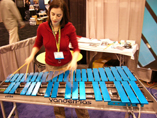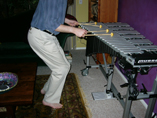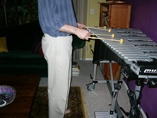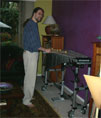PASIC 2003
Select your interest:
Page One: Health and Wellness; playing posture.
Page Two: Best of Show.
Page Three: New developments in mallet instruments.
Page Four: Miscellaneous instrument photos.
Height versus greatness
I'm six feet, five inches tall. I'm used to towering over most people.
But even so, it's amazing to me how short the people are at these percussion
shows. This holds especially true for classical percussion players and
marimba artists. I saw it time after time. Leigh Howard Stevens:
short. Alan Abel: short. Marimbists Nanae Mimura and Naoka
Takada: short. Here's a picture of up-and-coming vibraphone player
Lalo. I took this from my regular eye level:

Short!
We've always known that the majority of great percussionists are on the shorter side. It was only during this year's conference that I really began to ask myself why this was and to try and put myself in their (albeit constrictive) shoes.
Tone production from a master
I was standing at Nico VanderPlas's booth, chatting away, when Leigh Stevens
came up and hit a couple bars on Nico's instruments. Boy, did those couple
of notes sound really, really good! It made me aware of two things.
First, I've got to work on my tone production. Second, I noticed that,
from his height, Leigh was able to create a stroke in which the mallet hit the bar
at just about a perfectly perpendicular angle. His hand was just about the same
height as the head of the mallet. By contrast, I've got so many more
inches on him that my hand tends to be a few inches higher than the head of the
mallet. There's no way that I can make a nice full sound that way.
I also began to wonder about the visual difference. How much bigger might a bar look if I chopped a foot off my lanky body? I crouched down and witnessed the difference. It's quite noticeable! The thinner bars looked just about as wide as the wider ones had looked from my standard height, and the wider bars each looked to be about the size of Rhode Island. Hmmm. Could this be a reason why I miss so many notes?
The clinic that was worth all of my PASIC fees money
One of my main motivations for going to PASIC this year was a seminar
entitled "Injuries of the Hand, Wrist, and Forearm," held at 1:00 on
Thursday. I've suffered pain in my wrists since high school, often so
debilitating that I had to take months off at a time, so this topic was near to
my heart.
Clearly, I wasn't alone. The clinic was packed and overflowing. What I learned really blows me away. I'll share some of that here.
First of all, guess how many muscles there are in your fingers. Answer:
none! All of those muscles are actually located in your forearm, close to
your elbow. A bunch of tendons and nerves and such run through your wrists
(via the infamous carpal tunnels) and control your fingers remotely.
That control decreases the further the wrist flexes up, down, left or right off of its resting position. Think about that as you view these pictures of hands and
wrists:
A. Two-mallet examples (wrists horizontal):
 |
 |
|
neutral, ideal position (automatic for shorter players) |
flexed, compensatory position (used by most tall players) |
B. Stevens grip examples (wrists vertical):
 |
 |
 |
neutral position |
uppermost position |
downward-most position |
Notice that there's not really a tremendous range of
motion in our wrists. Instead, there's a "sweet spot range" of motion
which is quite clearly defined.
Tall players are always trained to "keep the wrists down." The second two-mallet picture (A, above) shows that strategy: the heads of the mallets are where they should be. But what we're not told is, mobility decreases as we flex our wrists to get to that position, and our fingers can't compensate (since it turns out that our fingers don't have any muscles in them with which to compensate).
We can easily feel that we don't have as much upward reach when we're in this compensatory position, since our wrists are already flexing up. What's not intuitive, though, is that we can't rely on our fingers to help us through this problem, because it turns out that finger motion doesn't start below the wrist. It starts above it. The flexed wrist is doubly bad: it wipes out not just our wrist mobility but also our finger dexterity.
Getting into neutral wrist position requires an amazing amount of crouching for a tall player. This photo shows what I had to do to get into the neutral positions shown above. This was at a vibraphone which, before the clinic, I had considered high enough:

Once I allowed the neutral hand position drive the instrument height, I took radical action. I raised my instrument to forty-two inches--higher than most people would ever dream of going and higher, honestly, than I had ever considered. Look at the difference in posture:
 |
 |
These pictures are unremarkable. They simply show a player with good, natural posture. But, for me, this is a breakthrough. I've never seen a photo of myself where I'm not slouching at an instrument. This good, natural posture came about without my having even thought about it. I was only thinking about getting my wrists into a neutral position. Once I moved my instrument up to where my wrists were in a neutral position, these photos were taken and I saw for myself the improvement in general posture.
I've begun playing at this new height. It's still too early for definitive decisions, but I've already noticed that good, strong tone production is easier, the bars look bigger (and are therefore easier targets to hit), and my back doesn't hurt so much. What an adjustment!
(Update, 2011: I have now been playing for many years using these elevated heights. After just a couple of months, the change felt perfectly natural. My wrists hurt much less, and my both my posture and my accuracy have improved. I now feel confident in recommending a similar height adjustment to all tall players.)
In conclusion, I urge all of you to consider careful your keyboard heights. Don't accommodate your body to the instrument. Accommodate the instrument to your body! With that in mind, I want to tell you what I consider to be the best of show, 2003: